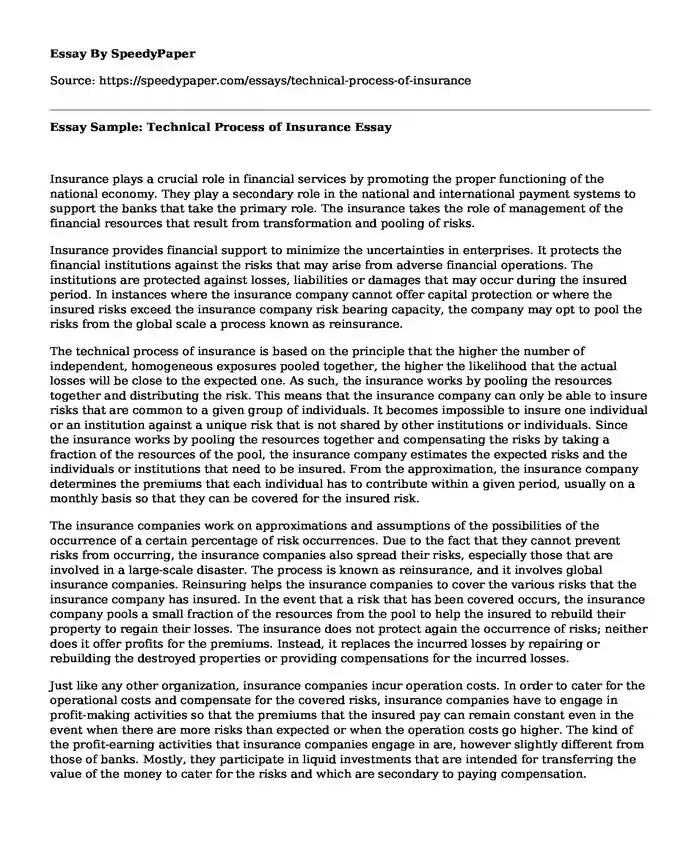Insurance plays a crucial role in financial services by promoting the proper functioning of the national economy. They play a secondary role in the national and international payment systems to support the banks that take the primary role. The insurance takes the role of management of the financial resources that result from transformation and pooling of risks.
Insurance provides financial support to minimize the uncertainties in enterprises. It protects the financial institutions against the risks that may arise from adverse financial operations. The institutions are protected against losses, liabilities or damages that may occur during the insured period. In instances where the insurance company cannot offer capital protection or where the insured risks exceed the insurance company risk bearing capacity, the company may opt to pool the risks from the global scale a process known as reinsurance.
The technical process of insurance is based on the principle that the higher the number of independent, homogeneous exposures pooled together, the higher the likelihood that the actual losses will be close to the expected one. As such, the insurance works by pooling the resources together and distributing the risk. This means that the insurance company can only be able to insure risks that are common to a given group of individuals. It becomes impossible to insure one individual or an institution against a unique risk that is not shared by other institutions or individuals. Since the insurance works by pooling the resources together and compensating the risks by taking a fraction of the resources of the pool, the insurance company estimates the expected risks and the individuals or institutions that need to be insured. From the approximation, the insurance company determines the premiums that each individual has to contribute within a given period, usually on a monthly basis so that they can be covered for the insured risk.
The insurance companies work on approximations and assumptions of the possibilities of the occurrence of a certain percentage of risk occurrences. Due to the fact that they cannot prevent risks from occurring, the insurance companies also spread their risks, especially those that are involved in a large-scale disaster. The process is known as reinsurance, and it involves global insurance companies. Reinsuring helps the insurance companies to cover the various risks that the insurance company has insured. In the event that a risk that has been covered occurs, the insurance company pools a small fraction of the resources from the pool to help the insured to rebuild their property to regain their losses. The insurance does not protect again the occurrence of risks; neither does it offer profits for the premiums. Instead, it replaces the incurred losses by repairing or rebuilding the destroyed properties or providing compensations for the incurred losses.
Just like any other organization, insurance companies incur operation costs. In order to cater for the operational costs and compensate for the covered risks, insurance companies have to engage in profit-making activities so that the premiums that the insured pay can remain constant even in the event when there are more risks than expected or when the operation costs go higher. The kind of the profit-earning activities that insurance companies engage in are, however slightly different from those of banks. Mostly, they participate in liquid investments that are intended for transferring the value of the money to cater for the risks and which are secondary to paying compensation.
Cite this page
Essay Sample: Technical Process of Insurance. (2019, Sep 25). Retrieved from https://speedypaper.net/essays/technical-process-of-insurance
Request Removal
If you are the original author of this essay and no longer wish to have it published on the SpeedyPaper website, please click below to request its removal:
- Free Essay Sample on Automotive Advancements in Technology
- Free Essay with a Rhetorical Analysis of Malcolm X, Message to the Grassroots Speech
- Free Essay Describing the Evolution of the Definition of Sociology
- Witness Tampering in the Criminal Justice System - Free Essay Example
- Paper Example on Why Online Classes are Better Than Traditional Classroom
- Essay Example. the Jealousy of Othello by William Shakespeare
- Biography of Dame Iris Murdoch: British Novelist and Philosopher
Popular categories





